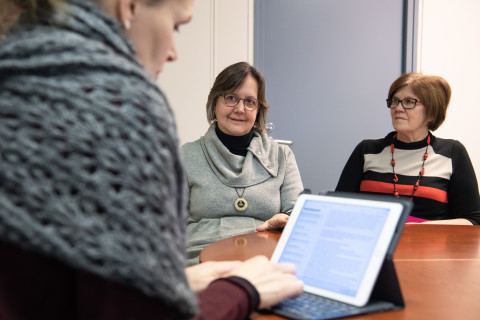How do nurses perceive the impacts of climate change in their work? Associate Professor Ruth McDermott-Levy has noticed that in Finland, many are surprised by this question.
“People are aware of climate change, but few have given a thought to the way it affects their work and the health of their patients,” notes Hannele Turunen, Professor at the Department of Nursing Science, University of Eastern Finland.
McDermott-Levy is a researcher in nursing science and the director of the Center for Global and Public Health at the American Villanova University, VU. She has spent this past autumn at UEF Kuopio Campus as a Fulbright Saastamoinen Foundation Health and Environmental Sciences Grantee. With the Department of Nursing Science, she has started a research project to collect Finnish nurses’ observations on the impact of climate change on their patients and their work.
“Nurses are the largest group of health professionals, and they are often the first to see such changes because nurses work in hospitals, clinics, schools, and in homes. They can provide us with the information needed to respond to patients’ changing health needs and then as educators, we can address the educational needs of nurses with regard to the health impacts of our changing climate,” McDermott-Levy points out.
Extreme weather events have become more common with climate change. “In Finland, extreme cold causes deaths, but increasing heat waves have become a health risk, too. This is especially a risk for the chronically ill and the elderly. Nurses may observe these issues when caring for the elderly at home, in clinics, and when patients are admitted to the hospital with heat-related problems such as dehydration, heart problems, and heat stroke.”
“In many Finnish homes, the ventilation windows are very small and there is not much air circulating on very hot days. This makes it difficult for the elderly to ventilate their houses and this could make it challenging to cope at home. Nurses will need to consider heat-related issues when they discharge elderly patients from the hospital to their homes.”
In Finland, winters are likely to be less snowy, cloudier and thus darker than before. “The darkness and diminishing opportunities for winter sports can take their toll on mental health and physical activities.”
In addition, climate change can affect air quality and pollen seasons and increase the spreading of some communicable diseases, such as tick-borne encephalitis and Lyme disease.
According to McDermott-Levy, climate change related issues should be approached in health care education from at least three angles. One is mitigation – actions taken to slow down climate change in hospital practice, for example. The second is adaptation – helping patients adapt to changing conditions. The third is resilience in addressing new challenges, such as hospitalizations in emergencies caused by extreme weather conditions or building systems to manage extreme weather events.
“As the largest and a trusted group of health care professionals, nurses can be in a key position and act as role models. They are also needed in decision-making and to convey a positive message instead of threat scenarios. For example, walking instead of driving a car is a healthy choice, but it’s a way to fight climate change, too.”
McDermott-Levy has been advancing the inclusion of climate change issues to health care education curricula in the United States, and she expects the ongoing study to yield more information on educational needs in Finland, specifically. During her visit to Kuopio, she has lectured on climate change and global health themes to students in nursing science and public health.
Additionally, there are plans to develop an online course for students from UEF and VU as well as from the Public Health Foundation of India and at the University of Calabar, Nigeria. Enembe Okokon, a PhD alumnus of the University of Eastern Finland, will be the participating professor from Nigeria. This course will support the development of health professionals who are prepared to be leaders in climate change and health on a global scale and it will support continued scholarship in this area for the faculty who are teaching the course.
Turunen believes that today’s students will make health care leaders willing to prepare for and take action against climate change. “Younger generations are especially aware of these issues and they want to make a change.”
There’s no previous research on the impact of climate change on Finnish nurses’ work. McDermott-Levy had no previous connection to the UEF Department of Nursing Science, either, when she suggested cooperation. The connection was made via the Global Consortium on Climate and Health Education, where the UEF Institute of Clinical Nutrition and Public Health was already a member.
“I hope our collaboration will continue in the future, and I also hope to see Finnish nurses joining our networks. There has been a lot of talk about climate change, but now it’s time to take action,” McDermott-Levy says.
Photo: Ruth McDermott-Levy (left) and Hannele Turunen believe that today’s students will make health care leaders willing to prepare for and take action against climate change.
